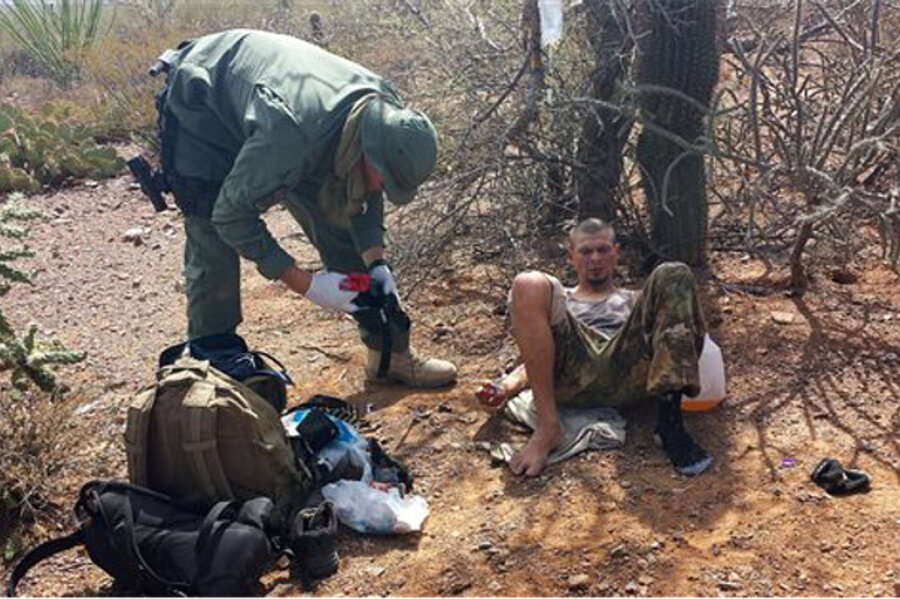Deaths at the US-Mexico border drop to 15-year low
Loading...
| TUCSON, Ariz.
The number of people who died trying to cross the US-Mexico border has dropped to the lowest level in 15 years as more immigrants turned themselves in to authorities in Texas and fewer took their chances with the dangerous trek across the Arizona desert.
The US government recorded 307 deaths in the 2014 fiscal year that ended in September — the lowest number since 1999. In 2013, the number of deaths was 445.
The Border Patrol's Rio Grande Valley sector finished the 2014 budget year with 115 deaths, compared with 107 in the Tucson sector, according to figures obtained by The Associated Press. It marks the first time since 2001 that Arizona has not been the deadliest place to cross the border.
Arizona has long been the most dangerous border region because of triple-digit temperatures, rough desert terrain and the sheer volume of immigrants coming in to the state from Mexico. But more immigrants are now entering through Texas and not Arizona, driven by a surge of people from Central America.
The Tucson and Rio Grande Valley both saw their numbers of deaths decline from 2013, although Arizona's drop was more precipitous.
Border enforcement officials say the lower numbers are in part due to increased rescue efforts as well as a Spanish-language media campaign discouraging Latin Americans from walking across the border.
Tucson Sector Division Chief Raleigh Leonard says the addition of 10 new rescue beacons that were strategically placed in areas where immigrants traverse most often has been a factor in the decrease in deaths.
"I think we can all agree that crossing the border is an illegal act, but nothing that should be assigned the penalty of death," Leonard said in an interview.
Immigrant rights advocates are skeptical that it is solely the Border Patrol's efforts contributing to the decrease in deaths.
"At best, what the Border Patrol is accomplishing is a geographical shift in where these deaths are happening — rather than adequately responding to the scale of the crisis," said Geoffrey Boyce, a border enforcement and immigration researcher at the University of Arizona and a volunteer with the Tucson-based nonprofit No More Deaths.
The Rio Grande Valley sector was flooded with a surge in unaccompanied minors and families with children who turned themselves in at border crossings in Texas. Most were from Honduras, Guatemala and El Salvador, where gang violence and a poor economy have driven out huge numbers of people. That surge has dwindled recently, however, as US and Central American authorities have launched a public relations campaign warning parents against sending their children to the US.
Meanwhile, the Tucson Sector, once the busiest in the nation, has seen a steep decline in border crossers. Fewer Mexicans are crossing into the US as the economy here has faltered and drug violence at home has improved.
The Border Patrol also responds to hundreds of cases each year of immigrants who need to be rescued while crossing the desert, long an issue in the Arizona desert. The Border Patrol conducted 509 rescues in the 2014 fiscal year in the Tucson sector, compared to 802 in 2013.
Some of the rescues are made with the help of beacons that were activated 142 times this year. The beacons are 30-feet tall, solar-powered and have sun reflectors and blue lights on top that are visible for 10 miles. The beacons also have signs in three languages directing users to push a red button that sends out a signal for help. Agents respond usually within 10 minutes to an hour.
The agency has a team dedicated solely to rescues, called Border Patrol Search, Trauma, and Rescue.
Agents in this elite group spend their days searching for immigrants and responding when one seeks help. They assist not only those who cross the border in search for jobs, but also drug mules and smugglers who become injured or dehydrated in the summer heat.
It was only 10 a.m. and already 95 degrees on a day in late June when the unit's agents provided medical assistance to a 28-year-old man suspected of smuggling drugs near Sells, Arizona.
The thin man had an ID from El Salvador and said he lived in Tucson. He oscillated between Spanish and English, but his message was the same: He was in extreme pain.
The agents gave him a gallon of a sports beverage. He was to drink it slowly, they told him, or else it would make him sick. Next, they connected a saline bag intravenously and checked his vitals.
The agents monitored him and re-examined his vitals, concluding that he wasn't dehydrated but suffering from muscle fatigue. Minutes later, agents who used a drug-sniffing K-9 to search the area found several bundles of marijuana and another suspected smuggler.
The men were arrested on suspicion of being in the country illegally, but were not charged with smuggling because the loads of marijuana were not found on them.
"To us, it could be a mule, an illegal immigrant. They're all the same. They're human beings," Leonard said.
___
Alicia A. Caldwell contributed to this report from Washington, D.C.





